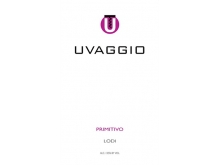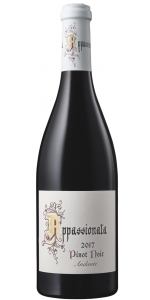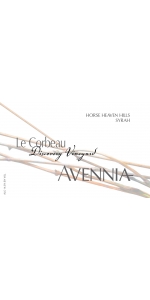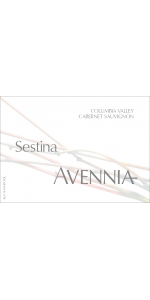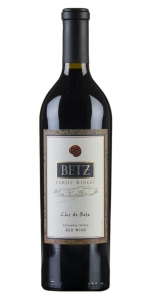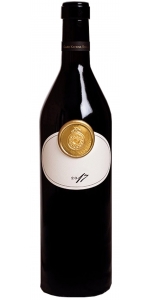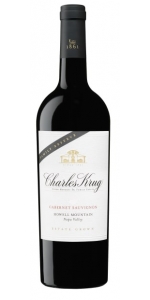Uvaggio Primitivo Lodi 2017
| Country: | United States |
| Regions: | California California (Lodi) |
| Winery: | Uvaggio |
| Grape Type: | Primitivo |
| Vintage: | 2017 |
| Bottle Size: | 750 ml |
Appasionata Andante Pinot Noir Willamette Valley is made from 100 percent Pinot Noir.
Named after the French word for Crow, or Raven, this Syrah is certainly as dark as the name implies. Hailing from Discovery Vineyard, perched high above the Columbia River in the heart of the Horse Heaven Hills, these grapes were grown in a very unique terroir. Avennia's approach of old-world style, minimalist winemaking allows for full expression of the fruit, showcasing the elegant and savory side of Syrah.
"Leads with a nice balance of dark fruits—blackberry and blueberry—with more savory elements, including blackberry leaf, olive, charcuterie, and a hint of shiitake. The palate features snappy fresh black fruits, a hint of smoked meat, and a lively finish with plenty of savory elements that make this wine quite interesting. Give it a year in the cellar and enjoy over the next eight years or so." - Chris Peterson, Winemaker
Reviews:
"Aromas of blackberry and violet accented by a note of stems. Sweet, supple wine with dark fruit flavors lifted by a black-peppery topnote and accented by cinnamony Red Hots. For all its high notes, this is essentially a creamy wine with no edges. I suspect it will tighten up in bottle and eventually display a more savory aspect. Incidentally, this will be the last vintage for this bottling because, beginning with vintage 2018, Chris Peterson will introduce some new single-vineyard Syrahs from the exciting new WeatherEye vineyard on top of Red Mountain. This steep site, owned by Cameron Myhrvold and farmed by Ryan Johnson, extends over the ridgeline and onto the northern flank of Red Mountain. The project is called Red Mountain Elevated, and Peterson is making the wines. (14.5% alcohol; done mostly in puncheons; vinified with 10% stems) - Stephen Tanzer”
- Antonio Galloni's Vinous (December 2019), 92 pts
"The last vintage for this cuvée, the 2017 Syrah Le Corbeau Discovery Vineyard is similar in style to the Arnaut yet offers slightly more floral notes in its blue fruits, wild strawberry, violets, rose petal, and sappy, forest floor aromas and flavors. Medium-bodied, with bright acidity and good balance, it’s a beautiful Syrah that leans heavily toward the fresh, elegant end of the spectrum while still offering tons of character and pleasure.”
- Jeb Dunnuck (April 2019), 92-94 pts
Each magnum is signed by the winemaker!
Avennia Sestina Cabernet Sauvignon is made from 77% Cabernet Sauvignon, 17% Merlot, 6% Cabernet Franc.
The story of this wine - The Sestina is an ancient form of poetry from Medieval France. Just as a modern poet can fill this form with new expressions, Avennia uses the traditional Bordeaux blend to express Washington. Sestina is their vision for an old vine, complex blend where all of the components complement each other. This wine is designed for the cellar, so the emphasis is on structure, balance, and complexity.
Winemaker Tasting Notes - “Good deep ruby/garnet color, with aromas of black cherry, fresh black currant, dark mocha, cigar box, and graphite. The palate is lively and dense with mountain berries, mocha, vanilla honey, damp earth, and wildflowers. The finish shows a distinct chalky minerality and beautiful tension. This is a classically balanced and ageworthy Sestina. Drink 2025-2040.” - Chris Peterson, Winemaker
Review:
"The Cabernet Sauvignon-dominated release from Peterson, the 2017 Sestina comes from the Red Willow, Bacchus, and Dionysus vineyards. Rocking levels of crème de cassis, sappy herbs, violets, and cedar pencil all flow to a full-bodied, incredibly pure, polished 2017 that offers flawless balance, ripe tannins, and a great, great finish. It's more approachable than normal yet is still going to evolve for 15 to 20 years. The blend is 77% Cabernet Sauvignon, 17% Merlot, and the rest Cabernet Franc, all raised 20 months in 50% new French oak."
- Jeb Dunnuck (April 2020), 95 pts
Betz Family Clos de Betz is 67 % Merlot, 27% Cabernet Sauvignon, 6% Petit Verdot
Review:
Full, dark ruby-red. Black fruit and licorice aromas are complicated by a mineral element. Wonderfully sappy, concentrated and ripe, with well-delineated Merlot-dominated flavors of black fruits, licorice and bitter chocolate conveying sexy sweetness. Finishes with plush tannins and excellent length. A superb vintage for this wine, clearly more concentrated and ripe than the 2016. Winemaker Skinner told me that the Petit Verdot element from Olsen vineyard is somewhat Pinot-like and actually softens this wine's tannins. And he noted that the cool late-season temperatures in 2017 allowed for easy picking. (aged until June of '18 in 60% new oak before being moved to neutral barrels for nearly another year of aging)
- Stephen Tanzer 93 Points
A blend of Merlot, Cabernet Sauvignon and Petit Verdot, the 2017 Clos de Betz has a vibrant expression on the nose, with plush, generous fruit aromas and an underlying brooding tightness. Full-bodied on the palate, the fleshy, plump fruit tones deliver a velvety lushness over the mid-palate, then the wine becomes more dusty and rigid on the finish, ending with oak spices that linger. I will revisit this swine in 36 months, as I suspect it will show better at a later date. This will easily last a decade and more. 750 cases produced.
-Wine Advocate 94 Points
Buccella Cuvee Katrina Eileen Napa Valley is made from 100% Cabernet Sauvignon.
Named after our first-born daughter, Cuvée Katrina Eileen is primarily composed of fruit from a vineyard in the Western Hills of Yountville, where yields are miniscule. The extremely rocky soil of the vineyard produces concentrated clusters of perfectly ripened Cabernet Sauvignon. In German, the name “Katrina” represents purity and fittingly, this wine is made entirely from the Cabernet Sauvignon grape, providing a pure expression of this decadent varietal. It also reflects our daughter’s personality with flavors that are complex, unreserved and expressive.
Always a 100% Cabernet blend, our 2017 Cuvée Katrina Eileen is an opulent and mouth-enriching wine. Captivated by the inky-black color, luscious scents of dark espresso and cinnamon stick leap out, along with powerful elements of graphite and cassis. Remarkably rich and seamless, while boasting flavors of blueberry compote, dark chocolate and black raspberries, this is a compelling and luxurious wine focused upon velvety texture, silky tannins and incredible length. An intentional breadth on the palate and length in the finish are hallmarks of this wine.
Charles Krug Family Reserve Howell Mountain Cabernet Sauvignon is made from 100 percent Napa Cabernet Sauvignon.
Rising 1,650 feet above the Napa Valley floor on the southwestside of Howell Mountain, the Family Reserve Howell MountainCabernet Sauvignon sits above the fog line. The distinctiveclimate, along with volcanic and iron-rich red soils, producefruit with great balance and intensity.
Review:
The 2017 Cabernet Sauvignon Limited Release Cold Springs is the most distinctive of the wines in this range of limited-release Cabernets from Charles Krug. Gravel, licorice, menthol and spice all develop in a Howell Mountain Cabernet endowed with tremendous class and nuance.
-Vinous 92 Points
Uvaggio Primitivo Lodi is made from 87% Primitivo, 13% Barbera
As we traverse the highways and byways of the wine world, the number-one question we encounter is “are Primitivo and Zinfandel really the same wine?” Well, yes and no. After years of genetic research, ampelographers discovered both are clones of a Croatian grape called Crljenak Kaštelanski (aka: Tribidrag). This means they’re not exactly the same (but oh so very close). It’s lively and fruity, generally offering a brighter expression than typical Zin (think fresh blueberries, not blackberry preserves). Neither Croatian or Pugliese, ours is a perfect complement with America's farm-to-table cuisine.
Decades ago we helped pioneer an 'old vine' Zin revial in the Napa AVA, plus planted Napa's first Primitivo. We have moved-on to a more cost effective AVA, sourcing from a vineyard planted for the Prisoner program.
Fruity and engaging; having a briary aroma of blackberry, floral notes like violet and a hint of spices like clove; with berry and cherry flavors, it has a bold and firm finish.
Uvaggio makes wine in California from grape varieties indigenous to Italy and the south of France.
Our theory is that if California has a climate which is great for growing Mediterranean varietals, why not take advantage of it? Since we have been on this path for a couple of decades now, we think we have found the right places, for growing these cultivar, primarily in Lodi So we urge you to discover this for yourself and try our wines.
Our expressions are steeped in California's traditions, with a nod towards Europe’s restraint, so you will our wines to be a contemporary synthesis of these two approaches. We produce white wines that are fresh, aromatic, dry and rarely exceed 12.5% alcohol. None of our barrel-aged reds are rarely exceed 14.5% alcohol. The only sweet wines we offer are purposely crafted to be sweet.
We are passionate about wine and food affinities, the magic that occurs when they resonant.
Always expand your horizons by trying something different.
Wine is meant to be enjoyed with food and always complement a meal.
One should endeavor to seek value and never fall prey to hype and high prices.
If you like one of our wines, please try another, in a quest for enjoying something new.
In By 1979 Jim had joined the Robert Mondavi Winery in Oakville and spent two decadess at what was then perhaps California’s most renowned, if not iconic, winery. Working for such an innovative and dynamic winery lead by a truly inspirational founder, afforded many benefits. In conjunction with course work in winemaking and wine business at UC Davis, his efforts resulted in several career milestones. Among them, he envisioned and developed La Famiglia di Robert Mondavi in California, while helping to launch Luce and Lucente from Tuscany - a collaborative effort with the Frescobaldi family of Florence.
Some of his other accomplishments included developing two vineyard trial blocks to evaluate the performance of Italian and Rhône varieties. He also helped to develop the company’s Burgundian-inspired, Carneros appellation Chardonnay and Pinot Noir. Jim reintroduced Zinfandel to the portfolio (from Napa Valley’s miniscule old vine sources) and totally revamped the style and packaging for Moscato d’Oro. His efforts earned many accolades, including three Wine Spectator Top 100 Wines of the Year, as well as a coveted “tre bicchiere” from Gambero Rosso, Italy’s pre-eminent wine guide. After being promoted to Assistant Winemaker, he was tasked with helping to elevate the quality of Mondavi’s entire Napa Valley portfolio and planned cellar renovations.
In 1998, Moore left Mondavi to develop l’Uvaggio di Giacomo, which translates as “the Blends of James” (or in other words “Jim’s Wine”) which he had begun with the 1997 vintage. He also served as the consulting winemaker for several new Napa Valley start-up ventures, along with helping revive the fortunes of a small, family winery in St Helena. Seeking a break from Napa Valley, in early 2003 he became Director of Winemaking for Bonny Doon Vineyard/Ca’ del Solo, only leaving to devote himself full time to revitalizing his Uvaggio project.
Today the Uvaggio label is a vinous statement four decades in the making. The diverse portfolio consists of a range of wines, though focuses on Vermentino and Primitivo. Emphasizing attributes like vibrant flavors, moderate pricing, lower levels of alcohol, and balanced expressions, these are wines crafted for food affinity and daily enjoyment, bringing an Italian sensibility to the American table. With a belief that wine’s primary role is to accompany a meal, the success of the Uvaggio rests on three important attributes - their accessibility, harmony and value.
Jim Moore is a graduate of UCLA and has traveled extensively in northern and central Italy and for several years worked side-by-side with winemakers in Tuscany. Valuable time was also spent during repeat visits to France’s Burgundy and Bordeaux regions. Jim resides in Napa, endeavoring to explore new vinous horizons daily.
Jim Moore’s creation and development of his own wine label - Uvaggio - is a gratifying personal achievement. His approach to winemaking seeks to optimize each vineyard’s potential by using rather basic and straightforward techniques to craft distinctive wines from lesser known grape varieties grown in the New World.
His winemaking style is as much Mediterranean as it is Californian Tasted blind, one might actually imagine they come from regions bounded by the Adriatic or Tyrrhenian Seas, not the Pacific Ocean. These are not typical wines from a typical winemaker. With a career spanning four decades and having vinified grapes from most of California’s diverse regions (and in several parts of Italy) and across a broad range of cultivars (everything from Arneis to Zinfandel), his winemaking experience is prodigious, differentiating the Uvaggio wines from California’s typical, Franco-centric offerings.
Jim’s interest in Italian grape varieties began long before Pinot Grigio became ubiquitous in the market. While working in restaurants during college, followed by managing a fine wine retailer, his exposure to a vast spectrum of the world of wine inspired taking up a career in winemaking.
Mel Knox’s insight, knowledge, curiosity, and connections were ultimately parlayed into a successful business importing and selling wine barrels. Taransaud and François Frères are among the French cooperages he helped establish as the go-to barrel manufacturers for winemakers in the USA. He has subsequently had wine cuvées (and children) named after him, and although presently immersed in a state of semi-retirement, he staves off senescence with his involvement in Uvaggio.
- back
All older vintage wines have been purchased from a single collectors cellar. Pictures can be requested before shipment.
Cabrieres Chateauneuf du Pape Rouge L'Esprit is made from 50% Grenache, 15% Syrah, 15% Mourvèdre, 10% Cinsault and 10% remaining: Muscardin, Counoise, Picpoul, Terret noir, Vaccarèse, Clairette, Bourboulenc, Roussanne, Picardan.
The vineyard is situated on the high tablelands, which are characteristic of the northern area of Châteauneuf-du-Pape. The terrain consists mainly of alpine diluvium and chalky Miocenian soil, with large flint pebbles covering the surface. These pebbles conserve the heat of the day during the night, thus avoiding too much evaporation.
85-year-old vines. Aged 12 months in French oak. Intense ruby color, with a dominant nose of black fruits (blackcurrant and blackberry) evolving into smoke and grilled notes. Robust tannins on the palate with a long finish.
Pair with choice red meat, prime rib and game, or try with strong cheeses and chocolate dessert.

